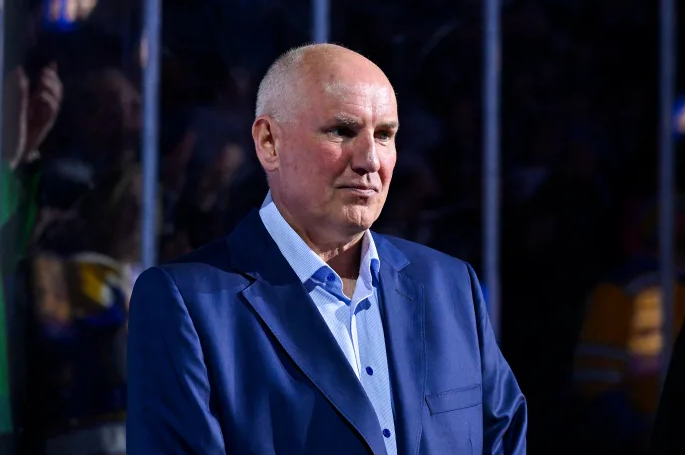
General Manager Doug Armstrong of the St. Louis Blues has shaken things up by tendering offer sheets to Edmonton Oilers restricted free agents Philip Broberg and Dylan Holloway, defying the unwritten rule of avoiding interference with other teams’ RFAs. This bold move could set a precedent for more teams to follow suit in the future.
Both Broberg and Holloway have shown promise, and their potential makes them valuable targets for the Blues. Broberg, a defenseman, and Holloway, a forward, are both restricted free agents, giving the Oilers a deadline to match the offers or face compensation in the form of draft picks.
Armstrong’s strategy not only puts pressure on the Oilers, who are already navigating a tight salary cap situation, but also highlights the competitive nature of the NHL. As teams look to strengthen their rosters, such moves could become more common, adding excitement to the offseason.

What was expected to be another uneventful August day in the NHL, as teams, media, and fans anticipated upcoming prospect tournaments and training camps, was suddenly energized by the St. Louis Blues’ bold move.
On a quiet Tuesday morning, the Blues made headlines by announcing that they had tendered offer sheets to not one, but two restricted free agents from the Edmonton Oilers: defenseman Philip Broberg and forward Dylan Holloway.
Both players were offered two-year contracts, with Broberg receiving $9,161,834 ($4,580,917 average annual value) and Holloway getting $4,580,914 ($2,290,457 AAV).
These players fit the age profile the Blues are targeting as they work to retool their roster while remaining competitive. Thus, it made sense for them to pursue this bold strategy, even if it upset another organization.
The reaction to this move was filled with surprise and outrage. Many questioned, “How could they do that?” There exists an unwritten rule, or a gentlemen’s agreement among general managers, that states, “You don’t interfere with my restricted free agents, and I won’t interfere with yours.” Doug Armstrong’s actions have clearly crossed a line that some consider sacred.
This marks only the second time that multiple offer sheets have been submitted to the same team simultaneously; the Blues were also involved in the first instance with the Boston Bruins back in 1991. The last offer sheet before this was the one from the Carolina Hurricanes to Jesperi Kotkaniemi of the Montreal Canadiens in 2019, which the Canadiens chose not to match.
There have been some notable examples in the past, like the Philadelphia Flyers’ massive 14-year, $110 million offer to Shea Weber from the Nashville Predators in 2012.
The Blues have been part of 12 previous offer sheets, whether they were the ones tendering or receiving them. Such occurrences are rare, with only 44 happening since 1986.
While I tend to lean towards traditional views in many areas, this is not one of them.
In fact, I would welcome seeing offer sheets become a more regular part of the NHL landscape. They are bold and challenging, demonstrating to fans that teams are genuinely committed to improving their rosters without overly concerning themselves with how other general managers manage theirs.

So what if it annoys another team? So what if it unsettles their fan base? The main goal is to improve your own team, and in this instance, the Blues are counting on two young players—Broberg, 23, and Holloway, who will turn 23 in September—to aid in their retooling efforts.
Does this put the Oilers and their newly appointed GM Stan Bowman in a tough spot? Absolutely, and that’s just fine.
It’s part of the game, so why not use the rules to your advantage whenever it can benefit your team? I appreciate that players are fair game in a situation that typically involves unwritten rules.
In my view, this move will compel teams to be more cautious in how they build their rosters moving forward. With the risk of losing restricted free agents, general managers may think twice before handing out extravagant contracts. Instead of spending freely, they might allocate their budgets more judiciously, knowing they need to reserve funds for their own players in case another team comes calling.

In this scenario, the Edmonton Oilers, the defending Western Conference champions, face a crucial decision regarding whether to retain one or both of Philip Broberg and Dylan Holloway or to accept the compensation, which would consist of a second- and third-round pick in 2025. Doug Armstrong cleverly structured the contracts to be $1 less than the threshold that would require a first- and second-round pick as compensation.
With Evander Kane reportedly needing surgery and heading to long-term injured reserve, the Oilers will gain some cap relief, but this won’t take effect until the season begins. Additionally, Edmonton must consider upcoming contract extensions for stars like Connor McDavid, Leon Draisaitl, and Evan Bouchard.
If the Oilers choose to keep both players, they would be over the salary cap by $7,225,541, according to puckpedia.com. This raises questions about whether they will need to trade other players to maintain their two first-round picks. Will they part with veterans they typically wouldn’t consider moving to stay compliant with the cap? Or do they believe they have internal options to fill the gaps left by Broberg and Holloway?
I believe that making offer sheets more common would encourage teams to think strategically in this salary cap era. While it may seem complex, it can be brilliant for teams and entertaining for fans and media alike, generating plenty of discussion.
From the Blues’ perspective, they have the cap space to pursue these moves. If the Oilers decide to keep the players, even at uncomfortable numbers, the Blues will have at least made an effort and could reclaim that cap space later in the season if they find themselves in contention.

The Blues’ Offer Sheet Strategy.
The St. Louis Blues have tendered offer sheets to Edmonton Oilers defenseman Philip Broberg and forward Dylan Holloway, both restricted free agents. The Blues see Broberg as a potential top-four defenseman who could form a long-term partnership with Colton Parayko. Holloway projects as a speedy third-line winger with the potential to develop into a second-line player.
The Oilers are understandably upset by this move, as it weakens their roster. However, the Blues are simply conducting business to improve their team, even if it ruffles some feathers. If the roles were reversed, the Oilers would likely do the same.
Broberg’s Fit in St. Louis.
At 23 years old, Broberg has shown flashes of potential and could still develop into a top-four defenseman. The Blues can afford to be patient with his development, unlike the Oilers who are in a “Cup or Bust” season. Broberg’s two-year, $4,580,917 AAV contract would require the Oilers to receive a 2025 second-round pick as compensation if they decline to match.
Holloway’s Upside.
Holloway, a 22-year-old forward, has the potential to be a valuable third-line winger with the possibility of moving up to the second line if he reaches his full potential. The Blues are betting on his speed and skill to bolster their forward depth.
The Precedent Set by Offer Sheets.
This move by the Blues sets a precedent that good, young players will get their payday sooner rather than later. While some may argue that some players are more deserving than others, it’s a business decision for the Blues. They are willing to take the risk of upsetting other GMs to improve their team.
The Oilers’ Response.
The Oilers may seek to retaliate against the Blues in the future, perhaps by targeting players like Jake Neighbours or Joel Hofer when they become restricted free agents in 2025. However, the Blues are unfazed by this possibility, as they are focused on making their team better in the present.
In conclusion, the Blues’ offer sheet strategy is a bold move that could pay dividends in the long run. While it may upset the Oilers and other GMs, the Blues are prioritizing their own team’s success and are willing to take risks to achieve their goals.

Leave a Reply